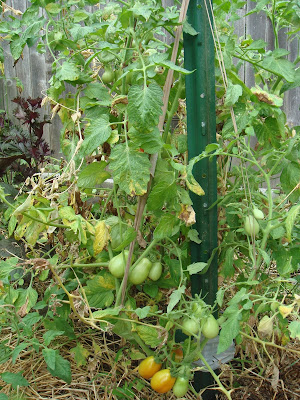Hubby used his day off on Friday to rent an auger and drill big holes in the yard around the perimeter of the garden. He then mixed concrete and set 2.5 inch posts into each of these holes. The top of the 2.5 inch post is just level with the ground. Into these ground posts we insert a 10 foot 2 inch pole. This allows us to completely take down the shade cover when it is not needed and not have ugly 10 foot posts sticking out of our garden year round. Poor hubby dug these holes and mixed concrete in the 102 degree heat on Friday... wow!
The shade cloth was purchased from Home Depot. The fabric is 6 feet wide and comes in 50 foot rolls for $77 each roll ($1.54 per foot). Lowes sells the same fabric on a by-the-foot cost of $1.75 per foot. We chose the tan colored fabric since it matched our house color.

We cut two rolls of fabric in half so we had four 25x6 foot sections. We sewed the long edges together to give us a cloth that was 24x25 feet long. Sections of fabric 25x6 long are hard to work with. We started sewing in the living room, then moved to the backyard so we could more easily handle the large size of the fabric.

The edges of the fabric 'should' be hemmed to provide additional strenght, but we were trying to get this thing up fast so we put this step off for later.

If the pictures seem a bit dark, it is because it was dark outside. Projects like this have to wait until after the kiddos have been put to bed.
Each corner of the fabric was rolled over a piece of 2x2 wood and zip ties were used to hold it in place. These hangers are tied to eyebolts set at the top of the vertical posts. A bit of trial and error was used to get the fabric to fit the garden well.

June 30th
Tonight we set the posts and tied off the corners of the shade cover.
We started at the back end of the garden. The posts were set outside our privacy fence.

The fabric was just draped across the plants at this point. We then found that the back end was too long and we had to re-tie the cloth to the hangers.

Adjusting the back end.

Almost up.
Once again, anohter project finsihed after dark.
















































